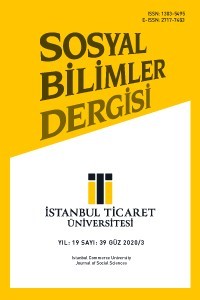YÜKSELEN PİYASA EKONOMİLERİNDE BİT YATIRIMLARI VE EKONOMİK BÜYÜME
BİT Yatırımları, Ekonomik Büyüme, İşgücü Kalitesi
ICT INVESTMENTS AND ECONOMIC GROWTH IN EMERGING MARKET ECONOMIES
ICT Investments, Economic Growth, Labor Quality,
___
- Agenor, P. R., & Aynaoui, K. E. (2003). Labor Market Policies and Unemployment in Morocco: A Quantitative Analysis. (W. B. Division, Dü.) The Policy Research Working Paper Series, 1-68.
- Almas, H., & Wanshan, Y. (2006). Contribution of ICT to the Chinese Economic Growth. The RATIO Institute. Seoul: The RATIO Institute and Techno-Economics and Policy Program .
- Ateş, S. (1998). Yeni İçsel Büyüme Teorileri ve Türkiye Ekonomisinin Büyüme Dinamiklerinin Analizi. Adana: Çukurova Üniversitesi Sosyal Bilimler Enstitüsü.
- Basilico, M. (2012). Aghion Notes. Harvard University. Boston: Harvard University.
- Beil, R., Ford, G., & Jackson, J. (2005). On the relationship between telecommunications investment and economic growth in the United States. International Economic Journal, Taylor & Francis Journals, 19(1), 3-9.
- Cattaneo, O., Diop, N., & Walkenhorst, P. (2007). The Potential for ICT-Development in Morocco. Researchgate.net, 1-18.
- Colecchia, A., & lSchreyerb, P. (2002). ICT Investment and Economic Growth in the 1990s: Is the United States a Unique Case? A Comparative Study of Nine OECD Countries. Review of Economic Dynamics, 408-442.
- CSLS. (2005). What Explains the Canada-US ICT Investment Intensity Gap? Centre for the Study of Living Standards for the Information Technology of Association Canada. Ottawa: Centre for the Study of Living Standards.
- Dedrick, J., Kraemer, K. L., & Shih, E. (2013). Information Technology and Productivity in Developed and Developing Countries. Journal of Management Information Systems, 30(1), 97-122.
- DEİK. (2018). Fas Ülke Bülteni. DEİK Ülke Bültenleri.
- DEİK. (2018). Fas Ülke Bülteni. Ülke Bültenleri.
- ECO . (2017, April). South Africa: what’s behind the growth slowdown? Eco Conjunkture BNP Paribas, p. 10-15.
- E-government Practice at the Information Solutions Group. (tarih yok). ICT as a key engine for development: good practices and lessons learned from Korea. E-government Practice at the Information Solutions Group. E-government Practice at the Information Solutions Group.
- Erdil, E., Türkcan, B., & Yetkiner, H. (2009, January 09). Does Information and Communication Technologies Sustain Economic Growth? The Underdeveloped and Developing Countries Case. Working Papers in Economics, p. 1-16.
- Hausman, J. (1978). Specification Tests in Econometrics. Econometrica, 46, 1251-1275.
- Hilbert, M. (2012, January). Towards a Conceptual Framework for ICT for Development: Lessons Learned from the Latin American “Cube Framework”. Information Technologies and International Development , 1-58.
- Jorgenson, D. W. (2001). Information Technology and the US Economy. American Economic Association, 91(1), 1-32.
- Karlsson, E., & Liljevern, J. (2017, June 15). Jönköping University International Business School. ICT Investment and the Effect on Economic Growth – a Comparative Study across Four Income Groups. Jönköping, Sweden: Jönköping University International Business School.
- Laubscher, E. (2018, July 14). Unskilled labour in South Africa. 2019 tarihinde medium.com: https://medium.com/@erichlaubscher1/unskilled-labour-in-south-africa-af56852ed443 adresinden alındı
- Mansell, R. (2014). Power and interests in information and communication technologies and development: exogenous and endogenous discourses in contention. Journal of International Development, 26(1), 109-127.
- Morocco The Global Competitiveness Index 2017-2018 edition. World Economic Forum.
- Niebel, T. (2018). ICT and economic growth – Comparing developing, emerging and developed countries. World Development, 104, 197-211.
- Piatkowski, M. (2003, October 01). The Contribution of ICT Investment to Economic Growth and Labor Productivity in Poland 1995-2000. TIGER Working Paper Series(43), p. 3-23.
- Pilat, D. (2004). The Economic Impacts of ICT – What Have We Learned Thus Far? OECD (Dü.), 4TH Zew Conference on the Economics of Information and Communication Technologies içinde (s. 1-28). Mannheim: OECD.
- Roller, L. H., & Waverman, L. (2001, September). Telecommunications Infrastructure and Economic Development: A Simultaneous Approach. American Economic Review, 91(4), 909-923.
- Tatoğlu, F. Y. (2012). Panel Veri Ekonometrisi. İstanbul: Beta .
- Total Economy Database - The Conference Board. (tarih yok). The Conference Board: https://www.conference-board.org/data/economydatabase/
- ISSN: 1303-5495
- Yayın Aralığı: Yılda 3 Sayı
- Başlangıç: 2002
- Yayıncı: İstanbul Ticaret Üniversitesi
STRATEJİK YÖNETİM AÇISINDAN STRATEJİK AR-GE FAALİYETLERİNİN İHRACATA VE EKONOMİK BÜYÜMEYE ETKİLERİ
Tuğba KARABULUT, Muhittin KARABULUT
KOBİLERİN YÖNETİMSEL SORUNLARINA YÖNELİK KOCAELİ VE İSTANBUL İLLERİNDE AMPİRİK BİR ÇALIŞMA
KABİN MEMURLARINDA TİP A/B KİŞİLİK YAPISININ ALGILANAN STRES ÜZERİNDEKİ ETKİSİ
Çağnur ZEHİROĞLU, Hüner ŞENCAN
İŞLETMELERDE SÜRDÜRÜLEBİLİRLİK KAVRAMI VE SÜRDÜLEBİLİRLİĞİ ETKİLEYEN ETMENLER
ÜLKELERİN REKABET ÜSTÜNLÜĞÜ GELİŞTİRMESİ: MARKA GÜÇ ENDEKSİ ÇALIŞMASI
İŞ DEĞERLERİ VE İŞ TATMİNİ İLİŞKİSİNDE LİDER ÜYE ETKİLEŞİMİNİN ARDIŞIK ARACILIK MODELİ
Meral YAY, Mine AFACAN, Ali Mertcan KÖSE
YÖNETİŞİM İLKELERİ VE YEREL YÖNETİMLER MEVZUATINA YANSIMALAR
PETROL FİYAT ŞOKLARI MAKROEKONOMİK ETKİLERİ
SATIŞ MÜDÜRLERİNİN GÖREV VE SORUMLULUKLARININ GENEL DEĞERLENDİRMESİ
BENLİK SAYGISI VE MATERYALİZMİN GÖSTERİŞÇİ TÜKETİM EĞİLİMİNDEKİ ROLÜ: GELECEĞE AİT BİR YAKLAŞIM
